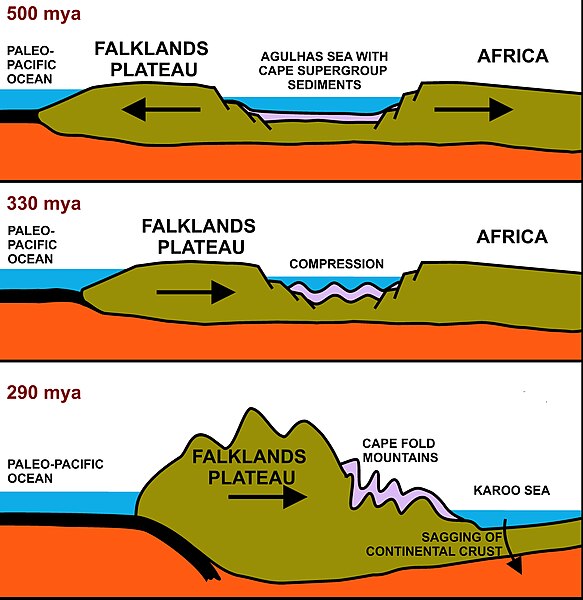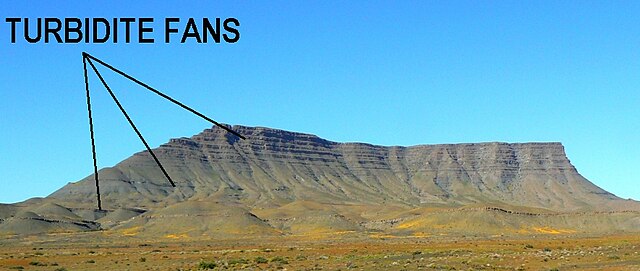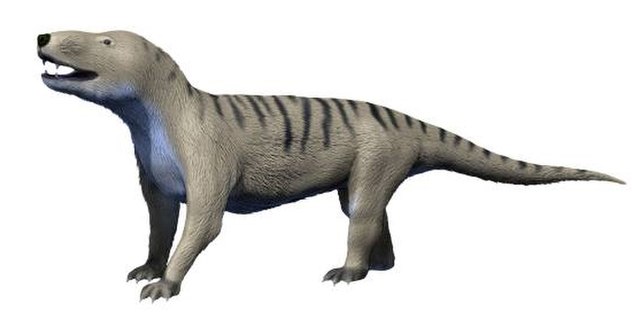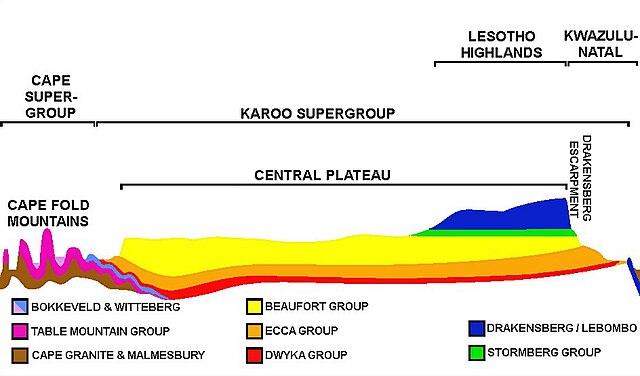Cynognathus Assemblage Zone
The Cynognathus Assemblage Zone is a tetrapod biozone utilized in the Karoo Basin of South Africa. It is equivalent to the Burgersdorp Formation, the youngest lithostratigraphic formation in the Beaufort Group, which is part of the fossiliferous and geologically important Karoo Supergroup. The Cynognathus Assemblage Zone is the youngest of the eight biozones found in the Beaufort Group, and is considered to be late Early Triassic (Olenekian) to early Middle Triassic (Anisian) in age. The name of the biozone refers to Cynognathus crateronotus, a large and carnivorous cynodont therapsid which occurs throughout the entire biozone.
Cynognathus crateronotus
Jammerbergia formops
Laidleria gracilis
Bauria cynops
The Karoo Supergroup is the most widespread stratigraphic unit in Africa south of the Kalahari Desert. The supergroup consists of a sequence of units, mostly of nonmarine origin, deposited between the Late Carboniferous and Early Jurassic, a period of about 120 million years.
An approximate SW-NE geological cross section through South Africa, with the Cape Peninsula (with Table Mountain) on left, and north-eastern KwaZulu-Natal on the right. Diagrammatic and not to scale. The color code of the Karoo Supergroup is the same as in the illustration above.

A north-south cross-section through the Agulhas Sea (see above). The brown structures are continental plates, the thick black layer on the left is paleo-Pacific Oceanic plate, red indicates the upper mantle, and blue indicates flooded areas or ocean. The top illustration depicts the geology about 510 million years ago, with the sediments which would eventually form the Cape Supergroup settling in the Agulhas Sea. The middle illustration depicts the Falkland Plateau drifting northwards once again to close the Agulhas Sea, causing the Cape Supergroup to be rucked into a series of folds, running predominantly east–west. The lowest illustration shows how subduction of the paleo-Pacific Oceanic plate under the Falkland Plateau, during the Early Permian period, raised a massive range of mountains. These eventually eroded into the Karoo Sea, forming, especially, the

Turbidites are deposited in deep water at the bottom of the edges of continental shelves or similar structures in deep lakes, such as the south-western Karoo Sea about 300 million years ago. They are the result of underwater avalanches of mud and sand cascading down the steep slope of the edge of the shelf. When the avalanche settles in the deep water trough, the sand and other coarse material settles first, then the mud and eventually the finest particles. Organic matter that came down with the avalanche ends up in the turbidite in an anoxic (oxygen free) environment where it is converted to

An Ecca mountain in the Tanqua Karoo, with multiple turbidite fans, indicating that the south-western portion of Karoo Sea was very deep, with steep slopes leading up to the shore line. The underwater avalanches were probably triggered by frequent earthquakes as the Cape Fold Mountains were being formed towards the south. The Ecca Turbidite deposits should not be confused with the dolerite sills found further inland (illustrated and described lower down, on the right, in the article) . The turbidites can be recognized at close quarters by the fact that the lowermost portion of each layer tends to be made up of sandstone which gradually grades into fine siltstone at the top of the layer.








